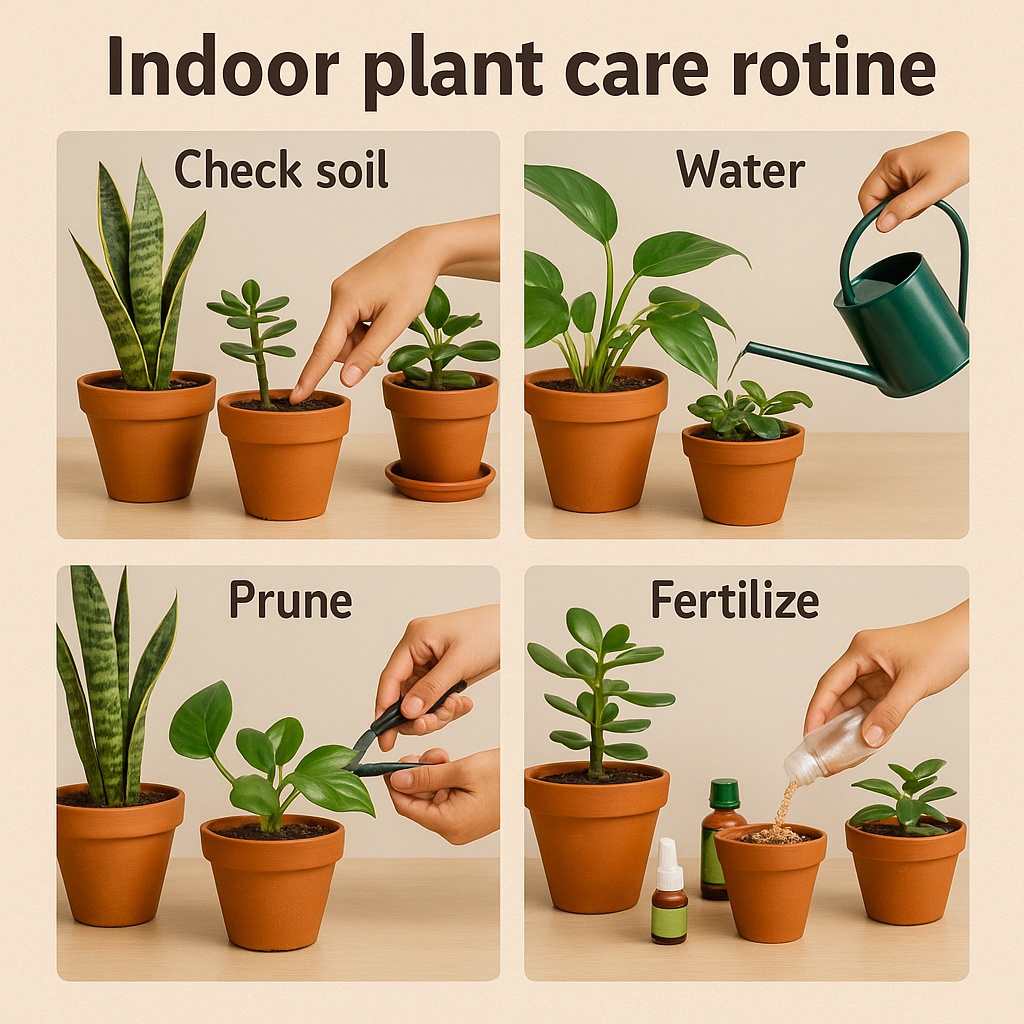Learning how to care for indoor plants doesn’t require a green thumb—just a consistent routine and a little knowledge. In this guide, you’ll discover the key steps and habits that will help you maintain healthy, vibrant, and long-lasting greenery inside your home.
Why Having a Routine Matters in Indoor Plant Care
Consistency is essential when it comes to how to care for indoor plants. A proper routine helps you:
- Avoid overwatering or underwatering
- Prevent pests and disease
- Encourage steady, healthy growth
- Reduce plant stress from seasonal changes
When you stick to a schedule, your plants will respond with beauty and vitality.
1. Watering: A Key Step in How to Care for Indoor Plants
Every plant has different water requirements. Here’s how to do it right:
- Check soil moisture: Stick your finger 1–2 inches into the soil
- Water only when needed: Most indoor plants prefer the soil to dry out slightly between waterings
- Use room-temperature water: This prevents shocking the roots
- Drain excess water: Ensure pots have drainage holes to avoid root rot
Tip: Group plants with similar watering needs together for convenience.
2. Lighting: An Essential Factor in Indoor Plant Care
Light is one of the most critical elements in how to care for indoor plants. Observe your space and match plants accordingly:
- Low-light plants: Snake plant, pothos, ZZ plant
- Bright indirect light: Monstera, peace lily, spider plant
- Direct sunlight: Cacti, succulents, aloe
Rotate your plants weekly to ensure even growth on all sides.
3. Cleaning Leaves: Keep Plants Healthy and Dust-Free
Dust can block light and clog leaf pores. Here’s how to clean effectively:
- Wipe leaves gently with a soft, damp cloth
- Use a soft brush or mist spray for textured or small-leafed plants
- Inspect regularly for pests such as spider mites or fungus gnats
Keeping leaves clean is an underrated part of how to care for indoor plants.
4. Fertilizing: Feed Your Plants Occasionally
Fertilizing gives plants the nutrients they need, but moderation is key:
- Use diluted liquid fertilizer during spring and summer
- Feed every 4–6 weeks depending on the plant type
- Avoid fertilizing in winter when growth slows
Too much fertilizer can do more harm than good.
5. Pruning and Trimming for Healthier Indoor Plants
Removing dead or overgrown parts helps your plant redirect its energy:
- Cut off yellow or wilted leaves
- Trim leggy stems to encourage bushier growth
- Always use clean, sharp scissors to prevent disease spread
Pruning is one of the best techniques in how to care for indoor plants effectively.
6. Repotting: When and Why to Do It
Plants outgrow their pots eventually. Signs it’s time to repot:
- Roots growing out of drainage holes
- Water passes straight through without soaking
- Plant growth has slowed noticeably
Choose a pot one size up and use fresh potting mix for better nutrition and drainage.
7. Pest Control and Plant Problem Solving
Here are common indoor plant issues and their causes:
- Yellow leaves: Often due to overwatering or poor drainage
- Brown edges: May indicate dry air or underwatering
- White fuzz or gnats: Signs of fungal growth or overly moist soil
Treat with neem oil or insecticidal soap. Isolate infected plants to prevent spread.
8. Humidity and Airflow: Often Overlooked, Always Important
Some indoor plants—especially tropical species—require higher humidity:
- Group plants together to increase localized humidity
- Use pebble trays or a humidifier
- Ensure adequate airflow to prevent mildew or mold
Balanced humidity and good air circulation are key parts of how to care for indoor plants long-term.

For another helpful plant care guide, check out our article on How to Make Self-Watering Plant Pots at Home.
Final Thoughts
Mastering how to care for indoor plants is all about observation and routine. When you water thoughtfully, provide proper lighting, prune regularly, and keep pests in check, your plants will thrive.
Stick to these tips and you’ll enjoy a lush, vibrant indoor jungle—no green thumb required.
You can buy watering cans, pruning shears, and indoor plant fertilizers here on Amazon.
